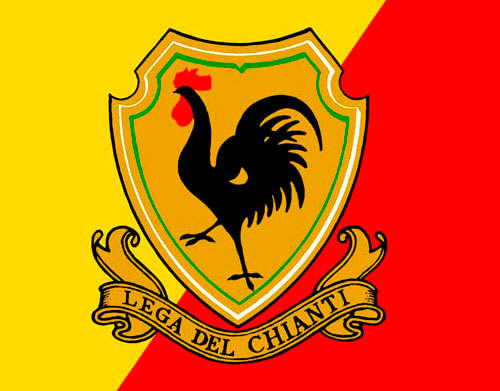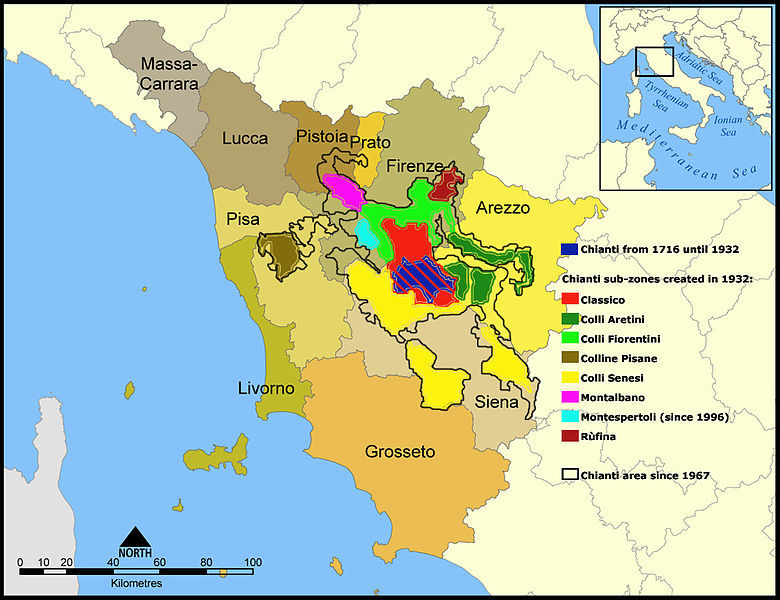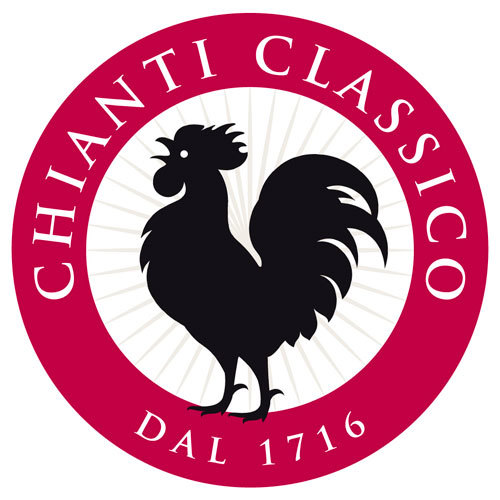The Chianti wine is an emblem of the great wine tradition of Tuscany and Italy. Produced according to strict quality standards since the Renaissance, Chianti wine was one of the first wines to be regulated by a production disciplinary.
It was Cosimo III de ‘Medici in 1716 to delimit the area, although the definition of the “Chianti region” (at administrative level is not a region) actually dates back to the Middle Ages, when some municipalities (Radda, Gaiole and Castellina) came together under the Lega del Chianti with the famous coat of arms of the Black Rooster.

Lega del Chianti
Chianti wine district is an area of central Tuscany. It is a hilly zone at the apex of which unfolds the short mountain range of the Chianti Hills, whose highest relief is Mount San Michele (893 meters above sea level). The area touches three Tuscan provinces, Florence, Arezzo and Siena.

Chianti area map
Around the famous black rooster brand develops the legend that sees the boundary between the Florentine and Sienese domains within the Chianti Classico, the oldest area of Chianti.
It is said that the two hegemonic powers of the area, the Republic of Florence and the Republic of Siena, have been fighting tirelessly for this border for years. To put an end to the dispute it was decided to adopt a rather singular method: at the first cockcrow at dawn, a knight of each of the two sides would leave and at their meeting point the Chianti border between the two republics would be fixed.
According to legend the Sienese chose a white rooster, while the Florentines chose a black one, which for the occasion was kept in a cage in the dark for a few days before the dispute. So it was that the poor animal, once opened the cage, began to sing well before dawn, giving the start to the Florentine knight well in advance of the Sienese one.
This would explain why the boundaries of Chianti Classico fell largely under Florentine rule even before Siena was subjugated to Florence.
Chianti is a dry red wine with a prevalence of Sangiovese (minimum 70%), the most important red grape variety in Tuscany, which can be produced in purity or blended with other grape varieties. Until the seventies, when it began to work so much on quality, obtaining great wines from Sangiovese in purity, the vine had always been blended with others. This is because the Sangiovese by itself gives wines of great freshness and tannins rather marked in youth; wines destined to last for a long time but at first a little grumpy.
Historically, the complementary grape varieties of Sangiovese were Colorino, Canaiolo nero, sometimes Ciliegiolo. Traditionally, the grapes of the two white grape varieties historically most important in the region were also used to lighten the wine (they are the basis of the production of Vin santo or Vinsanto, the most important sweet wine of the Tuscan tradition): Trebbiano toscano and Malvasia bianca lunga, or Malvasia del Chianti.
In addition to the autochthonous vines mentioned above, the international grape varieties Cabernet Sauvignon and Franc and Merlot are also used as complementary varieties of Sangiovese, capable of softening it and making it more appreciable even to less accustomed palates.
On the olfactory level, Chianti has the typical violet scent of Sangiovese, to which can be added other scents of the other grape varieties when produced in blends. The color is a young ruby red when Sangiovese prevails and when aging it tends to garnet red.
The taste is elegant and harmonious, good acidity and tannin, which with time is refined. Depending on the area of production and the soils, hints of small red fruits may prevail in the hills with stony soils, to arrive at more important structures with hints of ripe fruit (cherry or blackberry) in more clayey soils and with greater exposure.
Chianti wine represents one of the most important Italian and world wine denominations. In reality there are two denominations in the area: Chianti Classico DOCG, which includes the historically most ancient nucleus of Chianti (Radda in Chianti, Gaiole in Chianti, Castellina in Chianti, Greve in Chianti and parts of other neighboring municipalities) and Chianti DOCG which extends over a large area of central Tuscany, touching also the provinces of Pisa and Pistoia. For this last denomination there are also various sub-areas.
For Chianti Classico DOCG there are the following appellation:
For Chianti DOCG there are the following appellation:

Chianti Classico Logo
The disciplinary states that for the Chianti DOCG denomination, Sangiovese grape must be used for at least the 70%. The other permitted grape varieties are red vines provided for the Region of Tuscany. For the Chianti Classico DOCG, in addition to the lower yields per hectare, the minimum quantity of Sangiovese is set at 80%.
For the Chianti DOCG denomination the aging times vary according to the sub-area.
The ideal serving temperature of Chianti, as for all red wines, depends on many factors. If it is a very young wine, especially in summer it can be served at about 16 °C (exaggerating with the cold may accentuate the tannins too much). If it is a more mature wine it is better to be at 18 °C. For Chianti wines that have been aged for a long time, perhaps from an old vintage, you can go as high as 20 °C.
In the online shop of Fattoria Montecchio you can find the best of our production. A few clicks and the Chianti wine will arrive from our cellars to your home!
For those who want to live a dream vacation in the heart of Chianti Classico our farmhouse La Papessa is ready to welcome you.